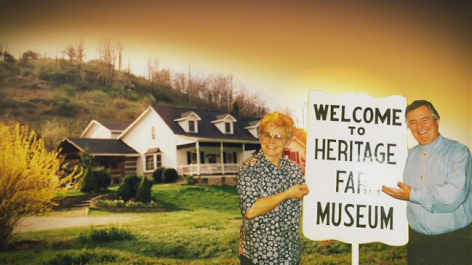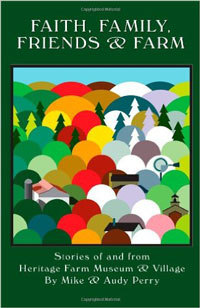

In 1973, co-founders Mike and Henriella Perry decided to relocate from, in Mike’s words, “a beautiful brick home in Huntington, West Virginia, to a burnt log cabin on a 150-acre farm.” It was in the process of making their new home livable that they discovered the old, hand-hewn logs hidden behind the farmhouse walls. “We fell in love. There’s no other way to put it,” Mike wrote. “We fell in love with our Appalachian ancestors, those men and women who came over the mountains into what is now West Virginia, eastern Kentucky, and southern Ohio. We imagined them clearing the land, building their homes, raising their own food, and making their own clothes from materials they processed themselves. Our ancestors’ hard work and perseverance have given to us a quality of life that, unfortunately, many of us take for granted today. As a tribute to these remarkable people, our family developed Heritage Farm Museum & Village.”
Mike and Henriella wanted to understand the tools and techniques involved in building a log cabin by hand. By combining this desire with their hobby of antiquing on the weekends as a family, they began to grow their collection. These authentic period materials and structures created a window into everyday life in Appalachia, from the 19th Century to the present.
After 20 years of collecting and building, Heritage Farm was opened to the public for the first time on May 4, 1996. For 10 years, this annual Spring Festival was the only day that the property was open. But, in 2006, regular hours were established to welcome guests throughout the year. In the time since, Heritage Farm has continued to grow, incorporating even more stories and aspects of Appalachian life.
Today, multiple museums and experiences comprise Heritage Farm Museum & Village. The Progress Museum contains scenes of everyday life from 1850 to 1950, as well as various artifacts and pictures from events throughout. The Transportation Museum houses not only planes, trains, and automobiles, but steam boats and stage coaches as well! In the Industry Museum, guests are invited to learn about some of the most important businesses from West Virginia’s history: salt mining, coal mining, and glass production. The Doll & Carriage Museum and re-created Country Store are both full of treasures and trinkets from yesteryear, while the Children’s Activity Museum allows kids to learn through hands-on opportunities. The Log Church welcomes guests into the center of the Village, and the Heritage Museum, which is only open during festival days, contains all of the artifacts from the original museum prior to expansion.
Experiences around the Farm range from observing to participating. Guests can spend time watching and talking with people doing the work required of our Appalachian ancestors. A blacksmith who works a forge, a seamstress who knits, and a printer who creates paper goods are just a few of the tasks happening on site. The petting zoo, nature center, and treehouse walk allow for up-close encounters with various animals who call Appalachia home. One of the newest experiences at Heritage Farm is the Adventure Park. Guests are encouraged to channel the daring spirit of the Appalachian explorers on the dueling 1100-foot long ziplines across the valley, a 40-foot tall challenging ropes course, a 15-foot tall ropes course designed for both kids and adults, and a mountain bike park with 6 downhill trails. If you would like to truly feel like a settler and spend more time around the Farm, overnight rentals and reception halls are available via reservation.
Heritage Farm Museum & Village has been recognized by various organizations over the years, such as receiving the designation as a National Geographic Traveler Prime Destination, as well as the Medal for Historic Preservation by the Daughters of the American Revolution. In 2015, the Smithsonian Institution recognized Heritage Farm as an official affiliate, the first and only in West Virginia. Additionally, The History Channel has filmed two projects at Heritage Farm: portions of America’s Greatest Feud: The History of the Hatfields & McCoys, and an episode of American Pickers, “Pickin’ Perry-dise.”
So what is the reason for all of this? How can a museum on the edge of Huntington, West Virginia, between the hills and curvy roads of rural Wayne County, help us learn from the past, appreciate today, and prepare for the future? Fortunately, Mr. Perry answered that very question: “We believe one way is to experience the museum and discover that change, and having to adapt to change, is nothing new. Change is as old as our wonderful hills. Our Appalachian ancestors endured unbelievable change as they struggled to cross the mountains, build their own homes, raise their own food, and even make their own clothes and footwear. How all of these things were done constantly changed as new and better ways were developed to do them. People were always striving to figure out how to do more, better, for less. If our ancestors could successfully adapt, so can we.”
Come join us as we celebrate Appalachian ingenuity and adventure!

To read more about the story above you can buy Mike Perry's book Faith, Family, Friends, and Farm: Stories of and from Heritage Farm Museum & Village at Amazon!
